Synchronization
Synchronizing connection data cross multiple systems
Introduction
XPipe can synchronize all connection configuration data across multiple installations. It uses your own remote Git repository for that purpose. You can synchronize with this repository in all XPipe application instances. Every change you make in one instance will be reflected in the repository. This approach means that you have full control over your data, as you can freely choose how and where to host this repository.
First of all, you need to create a remote repository with your Git provider of choice. This repository must be private. Next, copy and paste the URL into the XPipe remote repository setting.
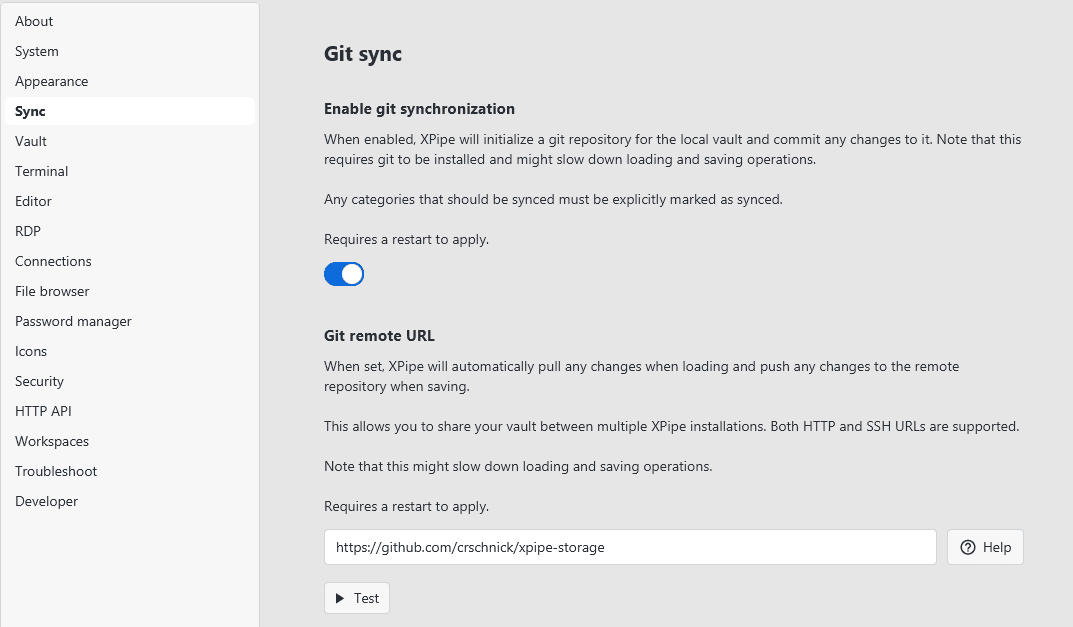
You also need to have a locally installed git client ready on your local machine. You can try running git --help in a local terminal to check.
If you don't have one, you can visit https://git-scm.com to install git.
Authentication
There are multiple ways to authenticate. Most repositories use HTTPS where you have to specify a username and password. Some providers also support the SSH protocol, which is also supported by XPipe. If you use an SSH URL for git, you probably know how to configure it, so this section will cover HTTPS only.
You need to set up your git CLI to be able to authenticate with your remote git repository via HTTPS. There are multiple ways to do that.
You can check if that is already done by clicking on the Test button below the remote repository URL in XPipe.
Credentials
If no credentials are configured, XPipe will ask you for your credentials on startup. To automate this, there are multiple ways to store your git credentials and handle authentication.
Many special tools like the GitHub CLI handle the whole authentication automatically for you when installed. Some newer git client versions can also authenticate via special web services where you just have to log in into your account in your browser. These approaches will store your credentials for your git client using a credential helper. For more information, see:
Alternatively, if no credentials are configured for your local git client yet, you have the option to specify them in XPipe itself:

Nowadays, most providers require a personal access token (PAT) to authenticate from the command-line instead of traditional passwords. You can find common PAT pages here:
- GitHub: Personal access tokens (classic)
- GitLab: Personal access token
- BitBucket: Personal access token
- Gitea:
Settings -> Applications -> Manage Access Tokens sectionSet the token permission for repository to Read and Write. The rest of the token permissions can be set as Read. XPipe just needs enough permissions to commit changes to the private vault repository.
If everything works out, XPipe should push an initial commit to your remote repository.
Syncing categories
By default, no connection categories are set to sync so that you have explicit control on what connections to commit. So at the start, your remote repository will be empty.
To have your connections of a category put inside your git repository, you first need to change its sync configuration.
In your Connections tab under the category overview on the left side, you can open the category configuration menu either by right-clicking the category or click on the ⚙️ icon when hovering over the category, and then clicking on the 🔧 configure button.

Then, set the Sync with git repository value to Yes to sync the category and connections to your git repository.
This will add all syncable connections in that category to the git repository.
The sync settings for a category are inherited by default from its parent if not explicitly set.

Adding files to git
When everything is set up, you have the option to add any additional files such as SSH keys to git as well. Next to every file choice is a git button that will add the file to the git repository.
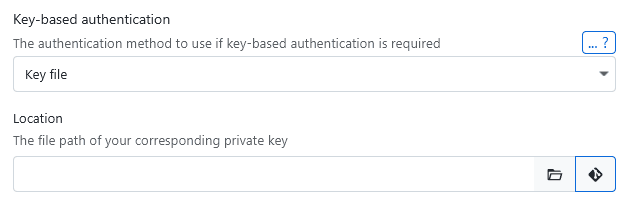
These files are then added to the git vault data directory and committed in encrypted form. This means that any files you add to git, such as keys, are only committed encrypted just as other secrets.
Local connections
Any connection located under the local machine cannot be shared as it refers to connections and data that are only available on the local system.
Certain connections that are based on a local file, for example, SSH configs, can be shared via git if the underlying data, in this case the file, have been added to the git repository as well.
GPG signing
If you have enabled GPG signing of your git commits, then this should work as expected. The only more complicated case is on Windows where you can have potentially two gpg executables with the git bash gpg and the native Gpg4win executable. By default, XPipe will choose the gpg client which has keys configured in it, under the assumption that you only use one of the two clients. If you switch between using both gpg clients, make sure that your git GPG key is available in gpg4win, as this client will be used if both clients have keys added.
Local repositories
If you don't want to host your remote git repository on some server somewhere and instead prefer a local option, for example, a flash drive, to sync data between machines, you can do that as well.
Git and XPipe support a file:// URL as well in addition to the more commonly used https and SSH URLs. You can create a local sync repository as follows:
Note that the --bare option is important, without it, git can't push to the repository.
Then, you can configure a file URL in XPipe:
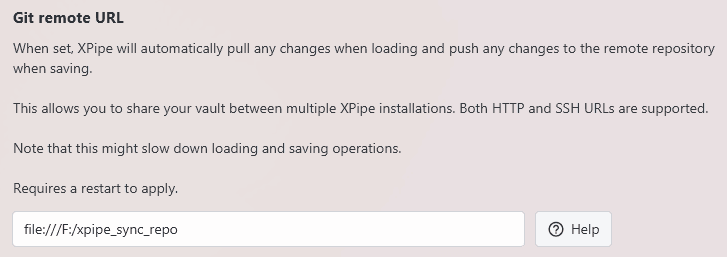
Note that the syntax for a file URL is file://<absolute path> where the absolute path on Windows has to be adjusted to use forward slashes and start with one as well. The path /home/user/xpipe_repo on Linux would become file:///home/user/xpipe_repo and the path C:\Users\User\xpipe_repo on Windows would become file:///C:/Users/User/xpipe_repo.
Reverting to a previous commit
In case anything goes wrong or you just want to restore the vault at an earlier date, you can do so easily using the normal git reset functionality. The first step is to find the SHA of the commit you want to revert to. This will look like this: 42e2e5af9d49de268cd1fda3587788da4ace418a. You can find the commit SHA in any web interface of git your provider or on the command line with git log.
Once you have obtained the SHA, you can run the following commands:
The push is required to overwrite the remote repository. Without the push, XPipe would just pull the changes from the remote repository again.
Note that if multiple instances are synced to this repository, you will have to perform the reset on all instance repositories. Otherwise, starting another XPipe instance where the local reset was not performed, will push the reverted changes again.
Team vaults
The git synchronization also supports multiple different users for when you are working with your team. It allows each team member to share access to systems that are designated to be available to all users, while also allowing each user to keep selected systems and authentication options private.
Vault users
To start off, each team member first has to sync to the same git repository. You can then configure the vault users in the Vault settings menu. Each vault user requires a passphrase to be set which will be used to encrypt personal secrets in the vault. With a passphrase, other users won't be able to decrypt any connections and identities marked as personal.

To mark an identity as personal, you have to create a synced identity:
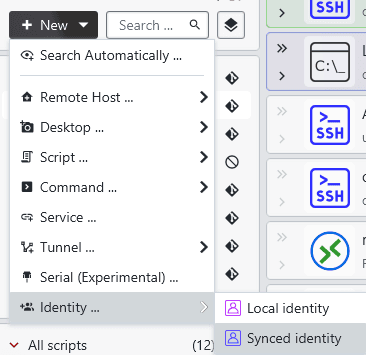
These identities can be configured to either be global or personal identities:

Then, configuring a connection to use this personal identity will automatically make XPipe also encrypt the connection itself and all subconnections with your personal key as well. This will result in only your user having access to the identity and all associated connections. Any kind of key files associated with personal identities are also added to the repository using your personal key for encryption.
Merge conflicts
When working in a team, an occasional merge conflict might occur when another user pushes changes while your local XPipe instance is running. XPipe will automatically check in the background if someone else pushed something to the remote and will attempt to perform a fast-forward merge automatically. You will see this notification when this happens:
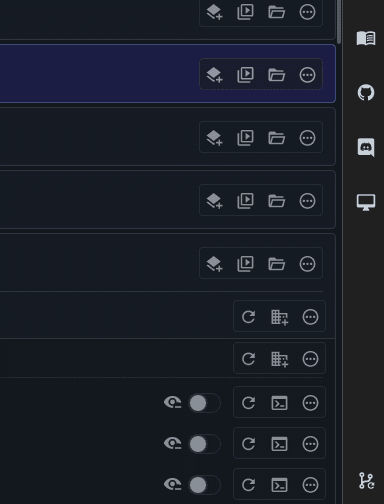
In most cases, you won't have to do anything as it can be handled automatically. However, if you and another team member modify the same connection configuration at the same time, you might receive a merge conflict error that can't be solved automatically. In this case, you can choose between either overriding your changes or the external changes.
